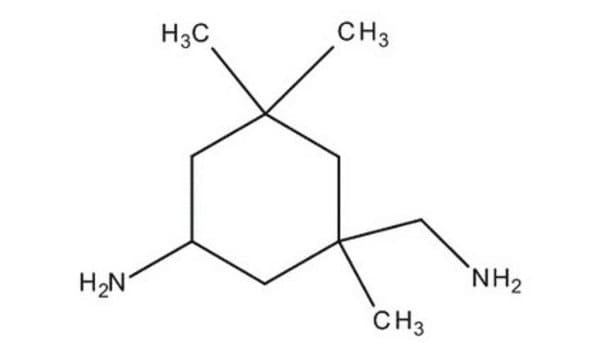Products may be shipped at a different temperature than the recommended long-term storage temperature. If the product quality is sensitive to short-term exposure to conditions other than the recommended long-term storage, it will be shipped on wet or dry-ice. If the product quality is NOT affected by short-term exposure to conditions other than the recommended long-term storage, it will be shipped at ambient temperature. As shipping routes are configured for minimum transit times, shipping at ambient temperature helps control shipping costs for our customers. For more information, please refer to the Storage and Transport Conditions document: https://www.sigmaaldrich.com/deepweb/assets/sigmaaldrich/marketing/global/documents/316/622/storage-transport-conditions-mk.pdf
368849
4,4′-Methylenebis(cyclohexylamine)
technical grade, 95%
Synonyme(s) :
4,4′-Diaminodicyclohexylmethane
Sélectionner une taille de conditionnement
Sélectionner une taille de conditionnement
About This Item
Produits recommandés
Qualité
technical grade
Pression de vapeur
<0.1 mmHg ( 38 °C)
Essai
95%
Densité
0.95 g/mL at 25 °C (lit.)
Chaîne SMILES
NC1CCC(CC1)CC2CCC(N)CC2
InChI
1S/C13H26N2/c14-12-5-1-10(2-6-12)9-11-3-7-13(15)8-4-11/h10-13H,1-9,14-15H2
Clé InChI
DZIHTWJGPDVSGE-UHFFFAOYSA-N
Vous recherchez des produits similaires ? Visite Guide de comparaison des produits
Catégories apparentées
Description générale
Application
- A curing agent for epoxy resins, facilitating the cross-linking process that leads to the formation of thermoset materials.
- A key component in the synthesis of polyurethane elastomers, which have been investigated for their biocompatibility and mechanical properties, making them suitable for biomedical applications.
- A monomer to synthesize porous organic polymers (POPs) via nucleophilic substitution reactions. These POPs are then tested for their ability to uptake iodine and for their fluorescence sensing performance related to dinitrophenol (DNP).
Mention d'avertissement
Danger
Mentions de danger
Conseils de prudence
Classification des risques
Acute Tox. 4 Oral - Aquatic Chronic 2 - Skin Corr. 1B - Skin Sens. 1 - STOT RE 2 Oral
Code de la classe de stockage
8A - Combustible corrosive hazardous materials
Classe de danger pour l'eau (WGK)
WGK 3
Point d'éclair (°F)
318.2 °F - closed cup
Point d'éclair (°C)
159 °C - closed cup
Équipement de protection individuelle
Eyeshields, Faceshields, Gloves, type P3 (EN 143) respirator cartridges
Faites votre choix parmi les versions les plus récentes :
Déjà en possession de ce produit ?
Retrouvez la documentation relative aux produits que vous avez récemment achetés dans la Bibliothèque de documents.
Les clients ont également consulté
-
How is shipping temperature determined? And how is it related to the product storage temperature?
1 answer-
Helpful?
-
-
How can I determine the shelf life / expiration / retest date of this product?
1 answer-
If this product has an expiration or retest date, it will be shown on the Certificate of Analysis (COA, CofA). If there is no retest or expiration date listed on the product's COA, we do not have suitable stability data to determine a shelf life. For these products, the only date on the COA will be the release date; a retest, expiration, or use-by-date will not be displayed.
For all products, we recommend handling per defined conditions as printed in our product literature and website product descriptions. We recommend that products should be routinely inspected by customers to ensure they perform as expected.
For products without retest or expiration dates, our standard warranty of 1 year from the date of shipment is applicable.
For more information, please refer to the Product Dating Information document: https://www.sigmaaldrich.com/deepweb/assets/sigmaaldrich/marketing/global/documents/449/386/product-dating-information-mk.pdfHelpful?
-
Active Filters
Notre équipe de scientifiques dispose d'une expérience dans tous les secteurs de la recherche, notamment en sciences de la vie, science des matériaux, synthèse chimique, chromatographie, analyse et dans de nombreux autres domaines..
Contacter notre Service technique















